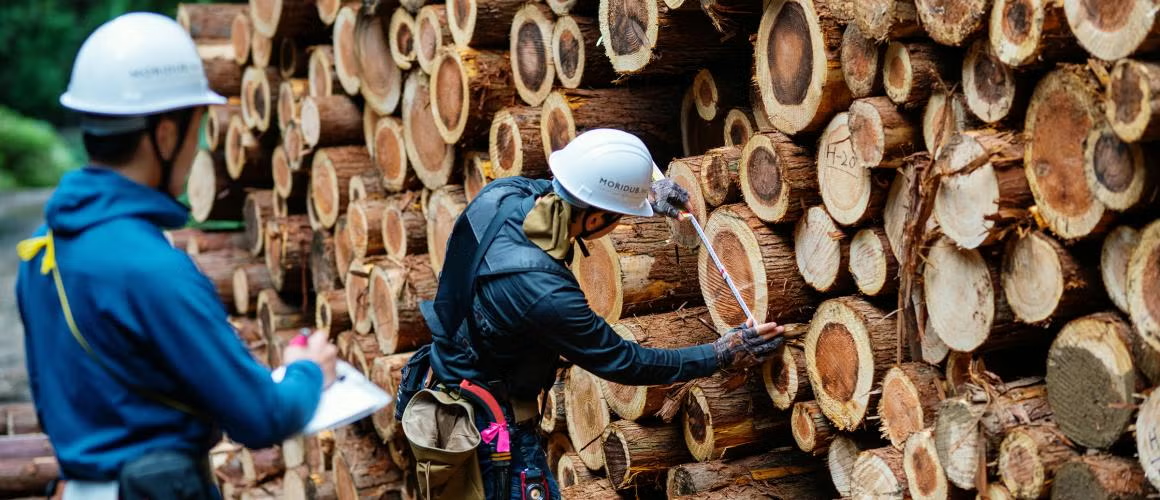The climate benefits of cross-laminated timber outweigh earlier concerns but only if managed responsibly, a recent Yale School of the Environment study found.
Replacing concrete and steel with mass timber in buildings could significantly reduce global carbon emissions and spur the expansion of intensively managed forests, a new study by Yale School of the Environment research scientists found.
Published in Nature Communications, the study offers a comprehensive global analysis of how the widespread use of engineered wood products like cross-laminated timber (CLT) could reshape land use and impact carbon storage through the end of the century. The research team modeled three future adoption scenarios and found that switching to CLT in 30% to 60% of new urban buildings from 2020 to 2100 could reduce life-cycle greenhouse gas emissions by 25.6 to 39 gigatons of CO₂ equivalent, which is roughly equal to total annual global energy-related CO₂ emissions, which reached around 37.8 gigatons in 2024, according to the International Energy Agency. It could also expand productive forestland globally by as much as 36.5 million hectares — an area roughly the size of Germany— by 2100.
“The main takeaway is that CLT is a good greenhouse gas mitigation strategy,” said Yuan Yao, associate professor of industrial ecology and sustainable systems and one of the corresponding authors of the study. “Using CLT instead of steel and cement will increase wood demand and encourage the market to protect more forestland and intensify forest management, which ultimately increases forest carbon stock.”
The study combined life-cycle assessment with the Global Timber Model (GTM), a long-established ecological-economic model. Unlike earlier analyses, the YSE-led work directly incorporates land-use dynamics into the life cycle modeling of wood products, accounting for how rising wood demand affects forest management and carbon flows across the system.
Another author, Robert Mendelsohn, the Edwin Weyerhaeuser Davis Professor Emeritus of Forest Policy, emphasized how the study challenges outdated assumptions about timber harvesting and deforestation.
“Previous research showed that mass timber reduces carbon emissions compared to steel and cement. But there were always questions about whether it was truly sustainable,” Mendelsohn said. “Some assumed that mass timber would deplete existing forests or draw on trees outside forested ecosystems. What we show, using GTM is that those assumptions don’t hold up. Modern timber harvesting is based on purpose-grown forests. If demand rises, more forests are planted — and that leads to more carbon being stored, not less.”
CLT adoption can increase afforestation in the U.S., China, Western Europe, and Canada while reducing marginal farmland. The carbon is sequestered not only in the growing forests but also in the mass timber itself, which locks carbon away in long-lived buildings.
However, the researchers noted that these benefits depend on responsible land-use planning. Unless stronger protections are implemented, the model projects a decline in some natural forests, particularly in tropical regions.
“There is a tradeoff between conservation and carbon goals,” Yao said. “Stricter protections can help but may also raise costs and reduce the carbon storage potential. Policymakers need to be aware of those tradeoffs when designing incentives.”
The lead authors of the study were Kai Lan, who conducted this research as a postdoctoral associate in Yao’s lab and is now an assistant professor in sustainability science and engineering at North Carolina State University, as well as Alice Favero who is a senior environmental economist at RTI International. Hannah Wang, a doctoral student in Yao’s lab also contributed to the study. This study was funded by Yale Planetary Solutions and the Yale Center for Natural Carbon Capture (YCNCC).
Looking ahead, Yao said she plans to explore how other forest-based carbon removal strategies, such as biochar production and bioenergy with carbon capture, could complement mass timber. “We’re interested in how different parts of the tree can be used in carbon-negative ways,” she said. “These synergies and tradeoffs across the forest product lifecycle are critical to understand.”
Mendelsohn added that there are still many outstanding questions, including how fast and where mass timber will be adopted around the world and how various economic and conservation policies could affect its role in global decarbonization.
